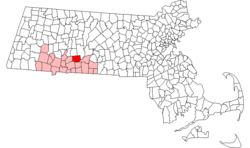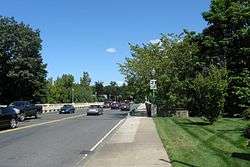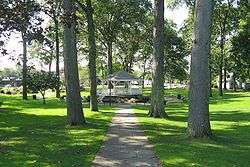Ludlow, Massachusetts
| Ludlow, Massachusetts | ||
|---|---|---|
| Town | ||
|
Ludlow Town Green | ||
| ||
| Nickname(s): Soccer City, The Bubble, Mini Portugal | ||
 Location in Hampden County in Massachusetts | ||
| Coordinates: 42°9′36″N 72°28′35″W / 42.16000°N 72.47639°WCoordinates: 42°9′36″N 72°28′35″W / 42.16000°N 72.47639°W | ||
| Country | United States | |
| State | Massachusetts | |
| County | Hampden | |
| Settled | 1751 | |
| Incorporated | March 29, 1774 | |
| Government | ||
| • Type | Representative town meeting | |
| Area | ||
| • Total | 28.2 sq mi (73.1 km2) | |
| • Land | 27.2 sq mi (70.3 km2) | |
| • Water | 1.1 sq mi (2.8 km2) | |
| Elevation | 550 ft (168 m) | |
| Population (2010) | ||
| • Total | 21,103 | |
| • Density | 748.3/sq mi (288.7/km2) | |
| Time zone | Eastern (UTC-5) | |
| • Summer (DST) | Eastern (UTC-4) | |
| ZIP code | 01056 | |
| Area code(s) | 413 | |
| FIPS code | 25-37175 | |
| GNIS feature ID | 0618187 | |
| Website | http://www.ludlow.ma.us/ | |
- For other places with the same name, see Ludlow (disambiguation).
Ludlow is a town in Hampden County, Massachusetts, United States. The population was 21,103 as of the 2010 census, and it is considered part of the Springfield Metropolitan Statistical Area. Located just northeast of Springfield across the Chicopee River, it is one of the city's suburbs. It has a sizable and visible Portuguese community.
History

Although plans were drawn up for settlement as early as 1685, within the original boundaries of Springfield, Massachusetts was settled in 1751 as Stony Hill Parish. [1] However, the town was later renamed Ludlow and incorporated as a separate entity in 1774, just before the breakout of the American Revolution.[2] For much of its early history the town was agrarian and today many of Ludlow's street names are derived from the names of these farming families (e.g. Chapin Street, Miller Street, Alden Street, Fuller Street). Ludlow was home to many sawmills and gristmills, utilizing the power from several sources of water nearby, the Chicopee River, Broad Brook, Higher Brook, and Stony Brook. Before the Civil War, the town began to develop into a mill town. This included the manufacturing of glass bottles by the many glassware companies, including John Sikes.[3] The District was renamed from Stony Hill to Ludlow for reasons unknown to this day. Then Governor of Massachusetts Bay Colony, Thomas Hutchinson renamed the town from the District of Stony Hill to Ludlow. The town of Ludlow was possibly named after Roger Ludlow, one of the founders of the Connecticut Colony or named after Ludlow, a town in England.
In 1868, the largest mill was opened and operated by the Ludlow Company (The Ludlow Clock Tower is depicted on the town seal), who produced jute yarns, twine, and webbing. This company helped shape the town by providing housing, a library, schools, playgrounds, and even a clubhouse for the increasingly diverse community.[2][4] In the 20th century, this company moved to India and is now known as Ludlow Jute and Specialties of Mumbai.[5]
In the early 20th century Ludlow developed from a mill town into a streetcar suburb of Springfield, Massachusetts, with a trolley line running over the bridge from Indian Orchard. Ludlow also had two railroads that traversed the town: the Springfield, Athol and North-eastern Railroad and the Hamden Railroad. The Hamden Railroad was closed and Interstate 90 was constructed over its former tracks. The Springfield, Athol, and Northeastern Railroad was reduced in length in the late 1930s as a result of the creation of Quabbin Reservoir. The train station for this line was at the corner of Winsor Street and Sewall Street and was the last station from Boston when the railroad closed in the 1950s. The train station was demolished in 1960. In 1981, the Stony Brook Power Plant was constructed in the town providing 517 Megawatts of electricity to 24 municipalities. In 1983, the plant became the first combined-cycle power plant in Massachusetts.[6]
Ludlow's population boomed in the 1950s with the creation of Interstate 90, known in Massachusetts as the Massachusetts Turnpike. John F. Thompson, who was Speaker of the House of Representatives in the Massachusetts General Court at the time, was influential in gaining an exit on the Turnpike for Ludlow (now Exit 7) and subsequently the Turnpike influenced the growth of Ludlow as a suburb of Springfield. Since the 1950s, the development of numerous subdivisions has added to Ludlow's growth.
Geography
According to the United States Census Bureau, the town has a total area of 28.2 square miles (73 km2), of which 27.1 square miles (70 km2) are land and 1.1 square miles (2.8 km2) (3.83%) is water. Ludlow is bordered by Chicopee on the west, Granby on the north, Belchertown on the northeast, Palmer on the east, Wilbraham on the south, and Springfield on the southwest.
Demographics
| Historical population | ||
|---|---|---|
| Year | Pop. | ±% |
| 1790 | 560 | — |
| 1850 | 1,186 | +111.8% |
| 1860 | 1,174 | −1.0% |
| 1870 | 1,136 | −3.2% |
| 1880 | 1,526 | +34.3% |
| 1890 | 1,939 | +27.1% |
| 1900 | 3,536 | +82.4% |
| 1910 | 4,948 | +39.9% |
| 1920 | 7,470 | +51.0% |
| 1930 | 8,876 | +18.8% |
| 1940 | 8,181 | −7.8% |
| 1950 | 8,660 | +5.9% |
| 1960 | 13,805 | +59.4% |
| 1970 | 17,580 | +27.3% |
| 1980 | 18,150 | +3.2% |
| 1990 | 18,820 | +3.7% |
| 2000 | 21,209 | +12.7% |
| 2001* | 21,413 | +1.0% |
| 2002* | 21,582 | +0.8% |
| 2003* | 21,641 | +0.3% |
| 2004* | 21,805 | +0.8% |
| 2005* | 21,996 | +0.9% |
| 2006* | 22,371 | +1.7% |
| 2007* | 22,382 | +0.0% |
| 2008* | 22,149 | −1.0% |
| 2009* | 22,165 | +0.1% |
| 2010 | 21,103 | −4.8% |
| 2011 | 21,100 | −0.0% |
| 2012 | 21,103 | +0.0% |
| * = population estimate. Source: United States Census records and Population Estimates Program data.[7][8][9][10][11][12][13][14][15][16] | ||
As of the census[17] of 2000, there were 21,209 people residing in the town. The population density was 752.1 people per square mile (290.1/km²). The racial makeup of the city was 95.78% White, 2.19% African American, 0.27% Native American, 0.68% Asian, 0.03% Pacific Islander, and 1.09% from other races. Hispanic or Latino of any race were 6.47% of the population.
Culture
Portuguese-Americans make up 21% of the population of the town.[18] The Portuguese church Our Lady of Fatima puts on an annual Festa, which is one of the most significant cultural events for Portuguese-Americans in the country.[19] Ludlow is also home to many who are of Polish and French Canadian descent. Soccer is an extremely popular sport in Ludlow. The town's high school soccer team is the most dominant in Western Mass and has recently been ranked 16th nationally by the NSCAA and has won many state championships as well, including the most recent one in 2011. The town is also home to the amateur Gremio Lusitano, and the Western Mass Pioneers and Western Mass Lady Pioneers professional soccer teams. The Pioneers play in the USL Second Division while the Lady Pioneers compete in the USL W-League. Both teams play their home games at Lusitano Stadium in Ludlow. In 1996, the National Soccer Hall of Fame added Ludlow to its soccer history display.
Education
The town is served by three public elementary schools, East Street School, Chapin Street School, and Veterans Park Elementary School. Previously students attended elementary school based on their residence, but starting with the 2009-2010 school year a reorganization plan took effect in which preschool, Kindergarten and First Grade attend East Street, grades 2-3 attend Chapin Street, and grades 4-5 attend Veterans Park. There is one public middle school, Paul R. Baird Middle School, and Ludlow High School is the town's only public high school.
The town also features St. John the Baptist School, a private school serving grades K-8 affiliated with St. Elizabeth Parish. The nearest vocational high school is Pathfinder High School in Palmer.
The nearest community colleges are Springfield Technical Community College and Holyoke Community College. The nearest state universities are the University of Massachusetts Amherst and Westfield State University. The nearest private colleges from the center of Ludlow are Western New England University, American International College, and Springfield College, all in Springfield.
Transportation
Ludlow is located at exit 7 on I-90, known as the Massachusetts Turnpike. State Highway 21 connects Ludlow to Springfield and Belchertown, and there are local bus routes to Springfield.
Bradley International Airport is 23 miles away and Logan International Airport is 77 miles away in Boston. There are bus stops along Center St., Winsor St. and East St. that connect Ludlow to Springfield.
The town once had a train station and almost featured two railroads. The first railroad was the Springfield, Athol and North-eastern Railroad which connected between Boston and New York. There was a spur of the railroad going to Athol but was cut off by the formation of the Quabbin Reservoir in the late 1930s. Ludlow was the last stop until 1960 when the train station shut down. The train later shut down shortly thereafter. The second railroad was an unopened bypass for the Springfield and Albany Railroad called the Hampden Bypass. It was built in the 1910s but the funding collapsed and never opened. The at grade was later used as the Massachusetts Turnpike from the Chicopee border to the Minnechaog Mountain curve about where Miller and East streets are today and continued onto Palmer. Several of the concrete structures still remain in the less populated areas of Ludlow.
Notable people
- Marco Alvan, Brazilian Jiu Jitsu instructor
- Chester W. Chapin, (1798-1883) businessman and a Massachusetts state representative
- Nicole Fiorentino, (1978-) bass guitarist for the band Smashing Pumpkins
- Gabriel Gonzaga, (1979-) UFC fighter
- Dean Lombardi, (1958-) general manager of the Los Angeles Kings of the National Hockey League
- Tom Matera, (1981-) World Wrestling Entertainment star, known as Antonio Thomas
- Mike Mushok, (1969-) guitarist from the rock band Staind
- Gretchen Palmer, (1961-) actress,
- Fred Pereira, (1954-) professional soccer player
- John F. Thompson, (1920–1965) Massachusetts state representative who served as House Speaker
- Maura West, (1972-) actress, known for her role in the soap opera As the World Turns
See also
References
| Wikimedia Commons has media related to Ludlow, Massachusetts. |
- ↑ Copeland, Alfred Minott. Our County and Its People; A History of Hampden County, Massachusetts. Hampden County: Century Memorial Pub. Co., 1902
- 1 2 Noon, Alfred. The History of Ludlow, Massachusetts. Springfield, MA: Higginson Book Company, 1912.
- ↑ Noon, Alfred. The History of Ludlow, Massachusetts. Springfield, MA: Higginson Book Company, 1912.
- ↑ Pillon, Karen. Ludlow (Images of America: Massachusetts). Mount Pleasant, SC: Arcadia Publishing, 1999.
- ↑ http://www.ludlowjute.com
- ↑ "Stony Brook Energy Center". ccj-online. Combined Cycle Journal. Retrieved 11 May 2015.
- ↑ "TOTAL POPULATION (P1), 2010 Census Summary File 1". American FactFinder, All County Subdivisions within Massachusetts. United States Census Bureau. 2010.
- ↑ "Massachusetts by Place and County Subdivision - GCT-T1. Population Estimates". United States Census Bureau. Retrieved July 12, 2011.
- ↑ "1990 Census of Population, General Population Characteristics: Massachusetts" (PDF). US Census Bureau. December 1990. Table 76: General Characteristics of Persons, Households, and Families: 1990. 1990 CP-1-23. Retrieved July 12, 2011.
- ↑ "1980 Census of the Population, Number of Inhabitants: Massachusetts" (PDF). US Census Bureau. December 1981. Table 4. Populations of County Subdivisions: 1960 to 1980. PC80-1-A23. Retrieved July 12, 2011.
- ↑ "1950 Census of Population" (PDF). Bureau of the Census. 1952. Section 6, Pages 21-10 and 21-11, Massachusetts Table 6. Population of Counties by Minor Civil Divisions: 1930 to 1950. Retrieved July 12, 2011.
- ↑ "1920 Census of Population" (PDF). Bureau of the Census. Number of Inhabitants, by Counties and Minor Civil Divisions. Pages 21-5 through 21-7. Massachusetts Table 2. Population of Counties by Minor Civil Divisions: 1920, 1910, and 1920. Retrieved July 12, 2011.
- ↑ "1890 Census of the Population" (PDF). Department of the Interior, Census Office. Pages 179 through 182. Massachusetts Table 5. Population of States and Territories by Minor Civil Divisions: 1880 and 1890. Retrieved July 12, 2011.
- ↑ "1870 Census of the Population" (PDF). Department of the Interior, Census Office. 1872. Pages 217 through 220. Table IX. Population of Minor Civil Divisions, &c. Massachusetts. Retrieved July 12, 2011.
- ↑ "1860 Census" (PDF). Department of the Interior, Census Office. 1864. Pages 220 through 226. State of Massachusetts Table No. 3. Populations of Cities, Towns, &c. Retrieved July 12, 2011.
- ↑ "1850 Census" (PDF). Department of the Interior, Census Office. 1854. Pages 338 through 393. Populations of Cities, Towns, &c. Retrieved July 12, 2011.
- ↑ "American FactFinder". United States Census Bureau. Retrieved 2008-01-31.
- ↑ Ludlow master plan committee minutes Thursday May 6, 2010 Page 2
- ↑ http://www.wwlp.com/dpp/news/local/wwlp_local_PortugueseAmericanFatimafesta_200909072206
 |
Granby | Belchertown | Belchertown |  |
| Chicopee | |
Palmer | ||
| ||||
| | ||||
| Springfield | Wilbraham | Wilbraham |


